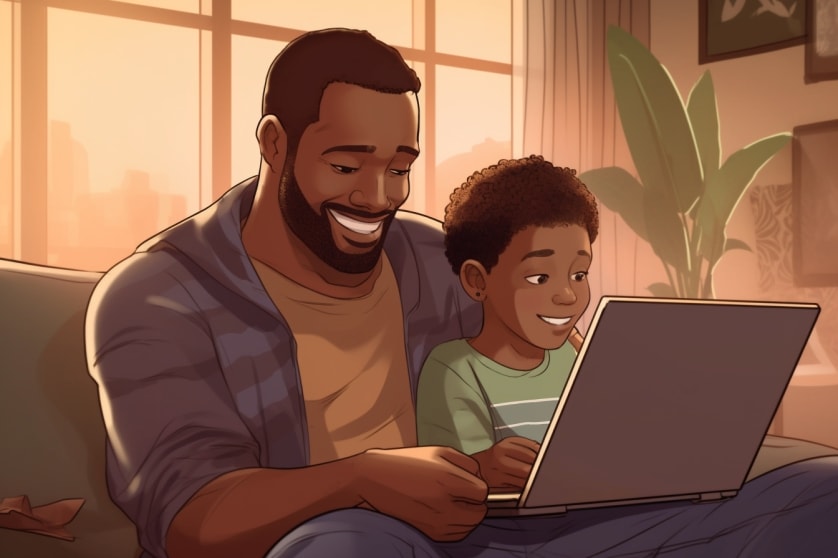Table of Contents
ToggleThe Parent’s Guide to Navigating the Digital World
Are you a parent trying to navigate the ever-changing landscape of the digital world? You’re not alone. With new apps, social media platforms, and online games popping up every day, it can be hard to keep up. But don’t worry, we’ve got you covered. In this guide, we’ll provide you with tips and strategies for keeping your child safe online and helping them become responsible digital citizens.
First, let’s face it, the digital world is a bit of a wild west. We all know that there are dangers lurking around every corner. From cyberbullying to online predators, it’s no wonder that parents are concerned about their children’s online activity. But what can you do to protect your child? How can you keep them safe while still allowing them to explore the digital world?
The good news is that there are plenty of ways to help your child navigate the digital world safely and responsibly. In this guide, we’ll provide you with practical tips and strategies for setting boundaries and limits, educating your child about online risks, monitoring their online activity, and staying up-to-date with the latest trends and dangers.
So, whether you’re a tech-savvy parent or a bit of a Luddite, this guide will provide you with everything you need to know about navigating the digital world with your child. From understanding the digital landscape to setting effective boundaries, we’ve got you covered. So buckle up, grab a cup of coffee, and let’s dive in!
- Learn practical tips and strategies for keeping your child safe online.
- Understand the potential risks associated with the digital world.
- Discover effective ways to set boundaries and limits on your child’s online activity.
- Learn how to educate your child about online risks and how to respond in different situations.
- Discover how to monitor your child’s online activity and stay up-to-date with the latest trends and dangers.
So, are you ready to become a digital-savvy parent? Let’s get started!

Section 1: Understanding the Digital World
Before we dive into the nitty-gritty of how to keep your child safe online, let’s take a step back and explore what the digital world actually is. At its core, the digital world refers to any technology that allows people to connect, communicate, and share information online. This includes social media platforms, messaging apps, online games, and even email.
While the digital world can be a fun and exciting place, it’s important to understand that there are also potential risks and dangers associated with it. For example, cyberbullying, online predators, and exposure to inappropriate content are all real concerns for parents and caregivers. That’s why it’s crucial to take the time to educate yourself on the digital landscape and understand the potential risks your child may face.
One key aspect of the digital world is the concept of anonymity. When we communicate online, it’s often easier to say things we wouldn’t say in person. This can lead to hurtful comments, cyberbullying, and other negative behaviors. Additionally, the internet is full of false information, and it can be challenging to distinguish fact from fiction.
Another thing to keep in mind is that the digital world is constantly evolving. New apps and social media platforms are introduced regularly, and it can be hard to keep up with the latest trends and features. That’s why it’s crucial to stay up-to-date and be aware of the latest dangers and risks.
So, what can you do to understand the digital world better? First and foremost, don’t be afraid to ask questions. If you’re not sure how something works or what a particular app does, do some research. There are plenty of online resources available to help you navigate the digital world, and many of them are geared specifically towards parents and caregivers.
- Understand what the digital world is and the potential risks associated with it.
- Be aware of the concept of anonymity and how it can lead to negative behaviors.
- Recognize that the digital world is constantly evolving and be proactive about staying up-to-date with the latest trends and features.
- Don’t be afraid to ask questions and seek out resources to help you navigate the digital landscape.
By taking the time to understand the digital world and the potential risks associated with it, you’ll be better equipped to help your child navigate it safely and responsibly. In the next section, we’ll explore practical tips and strategies for setting boundaries and limits on your child’s online activity.

Section 2: Setting Boundaries and Limits
Now that you have a better understanding of the digital world and the potential risks associated with it, it’s time to start thinking about how to set boundaries and limits for your child’s online activity. While it may be tempting to simply ban all screen time, that’s not always a practical or realistic solution. Instead, it’s important to find a balance that works for your family and your child’s needs.
One of the most important things you can do is set clear rules and expectations around screen time. This may include things like limiting the amount of time your child spends online, restricting access to certain apps or websites, and establishing guidelines around appropriate online behavior. It’s also a good idea to have regular check-ins with your child about their online activity and make sure they understand the rules and consequences for breaking them.
Another key aspect of setting boundaries and limits is modeling good behavior yourself. If you’re constantly glued to your phone or computer, your child is more likely to see that as acceptable behavior. Try to set a good example by practicing healthy screen habits yourself, such as setting aside dedicated screen-free time each day and limiting your own social media use.
When it comes to younger children, it’s important to supervise their online activity closely. This may mean setting up parental controls on their devices, monitoring their browsing history, and restricting access to certain websites or apps. It’s also a good idea to talk to your child about what they’re doing online and explain any potential risks or dangers in age-appropriate terms.
Finally, don’t be afraid to take a break from screens altogether. Encourage your child to engage in other activities, such as reading, playing outside, or spending time with friends and family. By fostering a healthy balance between screen time and other activities, you’ll help your child develop important social and emotional skills and reduce their risk of negative online experiences.
- Set clear rules and expectations around screen time and appropriate online behavior.
- Model healthy screen habits yourself.
- Supervise younger children’s online activity closely and use parental controls if necessary.
- Encourage a healthy balance between screen time and other activities.
By setting clear boundaries and limits around your child’s online activity, you’ll help them develop healthy screen habits and reduce their risk of negative experiences in the digital world. In the next section, we’ll explore strategies for talking to your child about online safety and promoting responsible online behavior.

Section 3: Educating Your Children
As a parent, one of the most important things you can do to protect your child in the digital world is to educate them about online safety and responsible behavior. By teaching your child about the potential risks and how to navigate the digital world safely, you’ll help them develop the skills they need to make informed decisions and stay safe online.
One of the first steps in educating your child about online safety is to talk to them about the potential risks. This may include things like cyberbullying, online predators, and identity theft. It’s important to have these conversations in an age-appropriate way and to use real-world examples that your child can relate to. For example, you could talk about a news story where someone was scammed online or a personal experience you’ve had with cyberbullying.
Another key aspect of educating your child about online safety is teaching them about responsible behavior. This includes things like being mindful of the things they post online, not sharing personal information with strangers, and being respectful of others online. It’s also important to talk to your child about the impact their online behavior can have on others and to encourage them to think critically about the things they see and read online.
There are a variety of resources available to help parents educate their children about online safety. Many organizations offer online safety courses and workshops for parents and children, and there are also a number of books and videos that can be used to teach children about online safety in an engaging and age-appropriate way. Additionally, many schools now incorporate digital citizenship and online safety lessons into their curriculum, so be sure to check with your child’s school to see what resources are available.
- Talk to your child about the potential risks of the digital world in an age-appropriate way.
- Teach your child about responsible online behavior and the impact it can have on others.
- Use available resources, such as online safety courses and books, to educate your child about online safety.
- Check with your child’s school to see what resources are available for teaching digital citizenship and online safety.
By educating your child about online safety and responsible behavior, you’ll help them develop the skills they need to navigate the digital world safely and confidently. In the next section, we’ll explore strategies for monitoring your child’s online activity and staying up-to-date on the latest digital trends and risks.

Section 4: Monitoring Your Child’s Online Activity
As a parent, it’s essential to monitor your child’s online activity regularly. Even if you’ve set up rules and limitations, your child may still come across inappropriate content or interact with people who could potentially harm them. Monitoring your child’s online activity allows you to identify these potential risks and address them immediately.
The Importance of Monitoring
Monitoring your child’s online activity is crucial for several reasons. Firstly, it allows you to protect your child from potential dangers, such as cyberbullying, inappropriate content, and online predators. Secondly, it gives you an opportunity to teach your child responsible online behavior and help them develop healthy digital habits. Lastly, it allows you to stay connected with your child’s interests and understand their online world better.
How to Monitor Your Child’s Online Activity
Here are some effective ways to monitor your child’s online activity:
- Use Parental Controls: Set up parental controls on your child’s device to limit access to inappropriate content and apps. This way, you can ensure that your child only accesses age-appropriate content.
- Check Browser History: Check your child’s browser history regularly to see the websites they’ve visited. This way, you can identify any sites that may be inappropriate for their age.
- Monitor Social Media Accounts: Monitor your child’s social media accounts by following them or being their friend. This way, you can see what they’re sharing, who they’re interacting with, and identify any potential red flags.
- Have Open Conversations: Have open conversations with your child about their online activity and encourage them to come to you if they see something that makes them uncomfortable. This way, they’ll feel comfortable discussing any concerns they have with you.
- Use Monitoring Apps: There are various monitoring apps available that allow you to track your child’s online activity. However, it’s essential to use them with caution and let your child know that you’re using them. Otherwise, it could erode the trust between you and your child.
Conclusion
Monitoring your child’s online activity is crucial in today’s digital age. By doing so, you can protect your child from potential dangers, help them develop healthy digital habits, and stay connected with their interests. Remember to use a combination of methods, including parental controls, open conversations, and monitoring apps to keep your child safe online.

Section 5: Staying Up-to-Date
As mentioned earlier, the digital world is constantly evolving and changing, and as parents, it’s essential to stay informed and up-to-date on the latest trends, apps, and social media platforms that your children are using. Here are some tips for staying informed:
1. Join Parenting Groups
There are numerous online parenting groups, communities, and forums that focus on digital parenting, where parents can discuss their concerns, share their experiences, and learn from one another. These groups can be an excellent resource for finding out about the latest digital trends, apps, and games, as well as learning from other parents’ experiences.
2. Attend Workshops and Webinars
Many organizations and groups offer workshops, seminars, and webinars on digital parenting. These can be great opportunities to learn about new apps, technologies, and social media platforms, as well as tips and strategies for keeping your children safe online. These events are often led by experts in the field, who can provide valuable insights and advice.
3. Read Blogs and Articles
There are numerous blogs and articles written by digital parenting experts, which can provide valuable insights into the latest trends and issues related to online safety. Reading these blogs regularly can help parents stay informed about the latest digital risks and strategies for keeping children safe online.
4. Talk to Your Children
One of the most effective ways to stay informed about the latest digital trends and issues is to talk to your children regularly. Ask them about the apps and games they are using, who they are talking to online, and what they are sharing. This can help you identify potential risks and concerns and take steps to address them.
5. Use Monitoring and Filtering Tools
There are numerous monitoring and filtering tools available that can help parents keep track of their children’s online activities, block inappropriate content, and limit screen time. These tools can be an effective way to stay informed and ensure that your children are using the internet safely.
By staying informed and up-to-date on the latest digital trends and issues, parents can better understand the risks and opportunities associated with the digital world and take proactive steps to keep their children safe online.
Conclusion
Congratulations! You’ve made it to the end of our guide on navigating the digital world as a parent. We hope that the information we’ve provided has been helpful in empowering you to keep your children safe online.
Remember, the internet is a vast and ever-changing place, and it can be overwhelming to keep up with all the latest trends and technologies. However, with the right tools and strategies in place, you can help your children navigate the digital world in a safe and responsible way.
As a parent, it’s important to stay vigilant and informed about the latest online risks and threats. Keep the lines of communication open with your children, and make sure that they feel comfortable coming to you with any concerns or issues they may encounter online.
At the end of the day, our goal as parents is to raise happy, healthy, and well-rounded children who are equipped with the skills and knowledge they need to succeed in all aspects of life, including the digital world.
Thank you for taking the time to read our guide, and we wish you all the best in your parenting journey!
Want to take your knowledge to the next level? Check out these must-read articles:
Organize your baby’s wardrobe with our baby clothes closet organizer products! Our organizers are designed specifically for baby clothes. Get your baby’s clothes neat and tidy with our selection of organizers – shop now!
Hey there, are you craving a fresh perspective? Look no further! Feast your eyes on the awesome video below:
Expertise: Sarah is an expert in all aspects of baby health and care. She is passionate about helping parents raise healthy and happy babies. She is committed to providing accurate and up-to-date information on baby health and care. She is a frequent speaker at parenting conferences and workshops.
Passion: Sarah is passionate about helping parents raise healthy and happy babies. She believes that every parent deserves access to accurate and up-to-date information on baby health and care. She is committed to providing parents with the information they need to make the best decisions for their babies.
Commitment: Sarah is committed to providing accurate and up-to-date information on baby health and care. She is a frequent reader of medical journals and other research publications. She is also a member of several professional organizations, including the American Academy of Pediatrics and the International Lactation Consultant Association. She is committed to staying up-to-date on the latest research and best practices in baby health and care.
Sarah is a trusted source of information on baby health and care. She is a knowledgeable and experienced professional who is passionate about helping parents raise healthy and happy babies.
- Baby Sign Language: Simple Starting Vocabulary - October 14, 2025
- The Pincer Grasp Revolution: Fine Motor Development - October 11, 2025
- Visual Development: Supporting Baby’s Changing Perception - October 10, 2025



